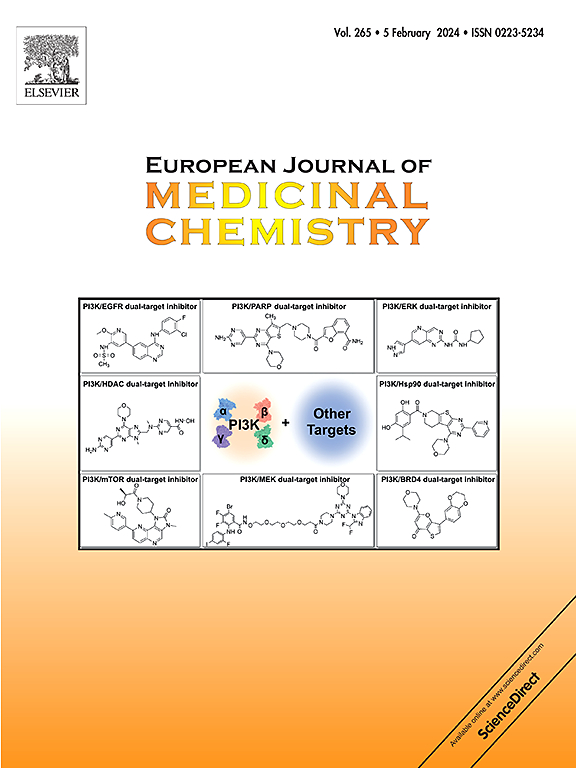Discovery of 3,4-dihydropyrimidine derivatives as novel Anti-PEDV agents targeting viral internalization through a unique calcium homeostasis disruption mechanism
IF 6
2区 医学
Q1 CHEMISTRY, MEDICINAL
引用次数: 0
Abstract
Porcine epidemic diarrhea virus (PEDV) poses critical challenges to global swine production, with current vaccines showing limited efficacy against emerging strains. To address this gap, we designed 41 novel 3,4-dihydropyrimidine derivatives via systematic structure-activity relationship (SAR) optimization. Compound D39, incorporating a C-4 2′-substituted biphenyl, C-2 thione, C-6 phenyl, and C-5 isopropanol substituents, emerged as the most potent anti-PEDV agent (EC50 = 0.09 μM, SI = 358.9), outperforming remdesivir (EC50 = 3.14 μM, SI > 40.8) by 35-fold. D39 exhibited broad-spectrum anti-coronavirus activity (FIPV, IDV) at micromolar levels and demonstrated acceptable metabolic stability (T1/2 = 78.75 min, Clint = 8.8 μL/min/mg) in porcine liver microsomes. Mechanistic studies revealed the antiviral actions was achieved by blocking PEDV early internalization via intracellular Ca2+ homeostasis modulation. These findings highlight D39 as a first-in-class anti-PEDV candidate with a unique dihydropyrimidine scaffold and a calcium-targeting mechanism, offering a promising therapeutic strategy against coronaviral infections.


发现 3,4-二氢嘧啶衍生物作为新型抗 PEDV 药物,通过独特的钙平衡破坏机制靶向病毒内化
猪流行性腹泻病毒(PEDV)对全球养猪生产构成了严峻挑战,目前的疫苗对新出现的病毒株的效力有限。为了解决这一问题,我们通过系统构效关系(SAR)优化设计了41个新的3,4-二氢嘧啶衍生物。含有C-4 2′取代的联苯、C-2硫酮、C-6苯基和C-5异丙醇取代基的化合物D39是最有效的抗pedv药物(EC50 = 0.09 μM, SI = 358.9),优于remdesivir (EC50 = 3.14 μM, SI和gt;40.8)乘35倍。D39在猪肝微粒体中具有广谱抗冠状病毒活性(FIPV, IDV)和良好的代谢稳定性(T1/2= 78.75 min, Clint =8.8 μL/min/mg)。机制研究表明,抗病毒作用是通过细胞内Ca2+稳态调节阻断PEDV早期内化实现的。这些发现突出了D39作为一流的抗pedv候选物,具有独特的二氢嘧啶支架和钙靶向机制,为对抗冠状病毒感染提供了有希望的治疗策略。
本文章由计算机程序翻译,如有差异,请以英文原文为准。
求助全文
约1分钟内获得全文
求助全文
来源期刊
CiteScore
11.70
自引率
9.00%
发文量
863
审稿时长
29 days
期刊介绍:
The European Journal of Medicinal Chemistry is a global journal that publishes studies on all aspects of medicinal chemistry. It provides a medium for publication of original papers and also welcomes critical review papers.
A typical paper would report on the organic synthesis, characterization and pharmacological evaluation of compounds. Other topics of interest are drug design, QSAR, molecular modeling, drug-receptor interactions, molecular aspects of drug metabolism, prodrug synthesis and drug targeting. The journal expects manuscripts to present the rational for a study, provide insight into the design of compounds or understanding of mechanism, or clarify the targets.

 求助内容:
求助内容: 应助结果提醒方式:
应助结果提醒方式:


